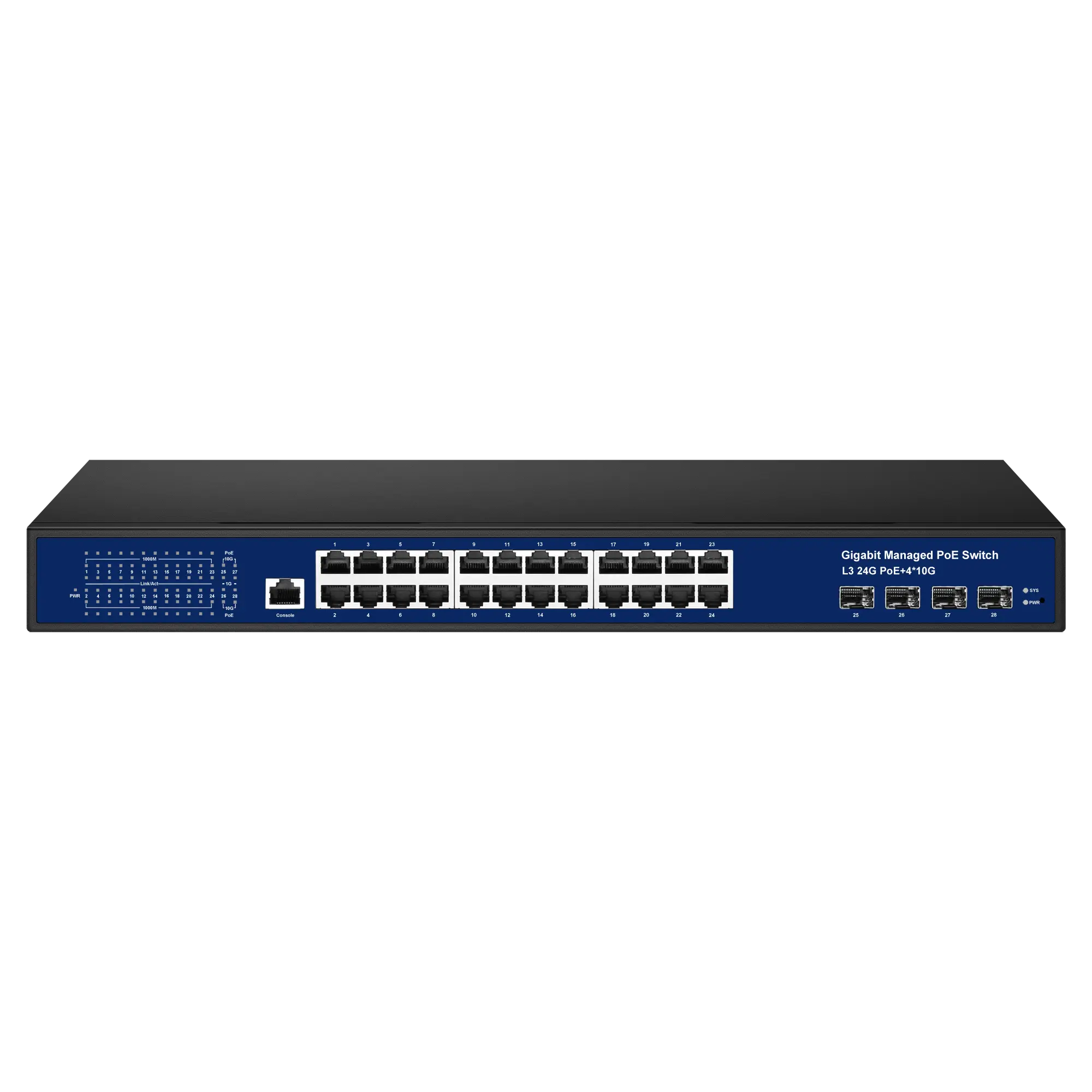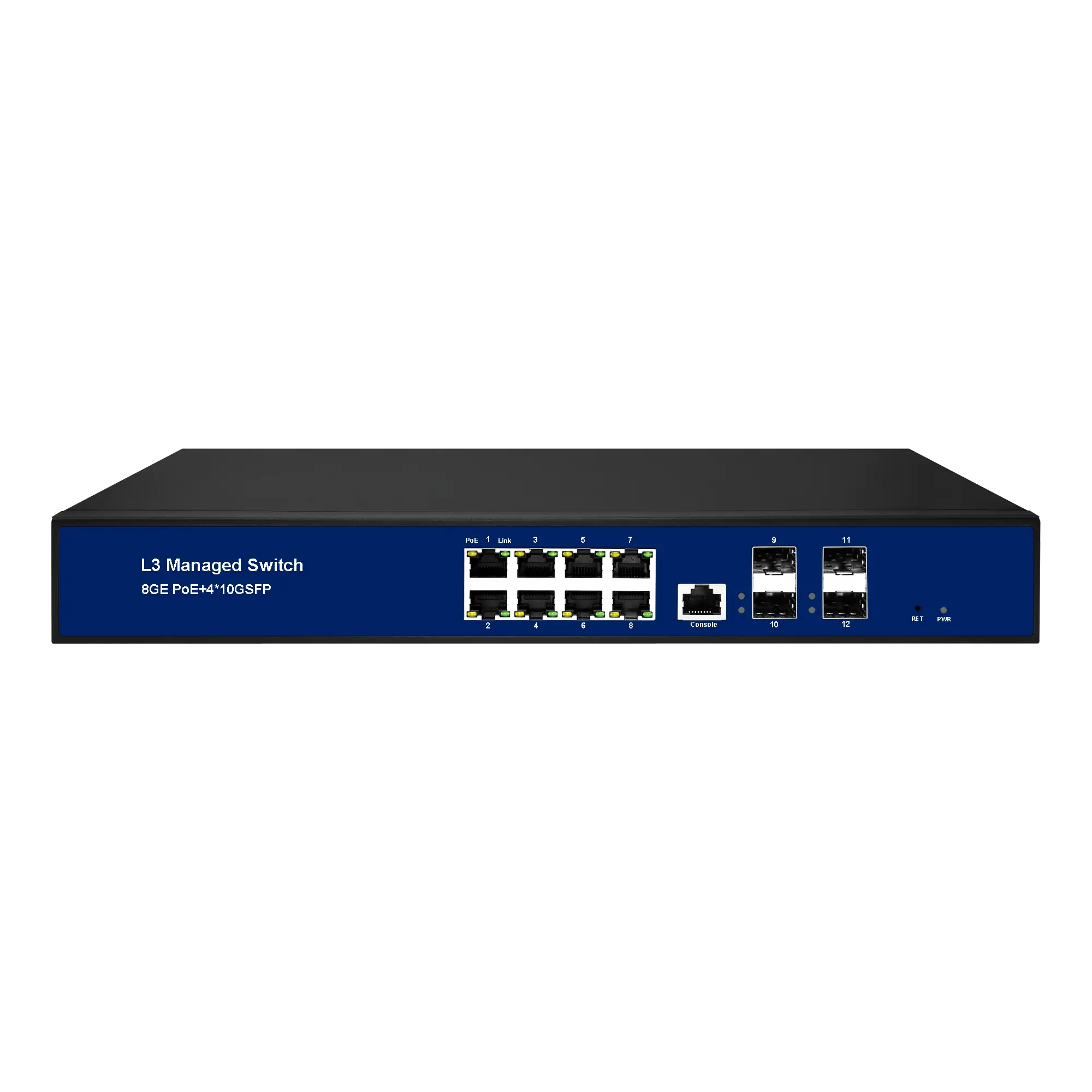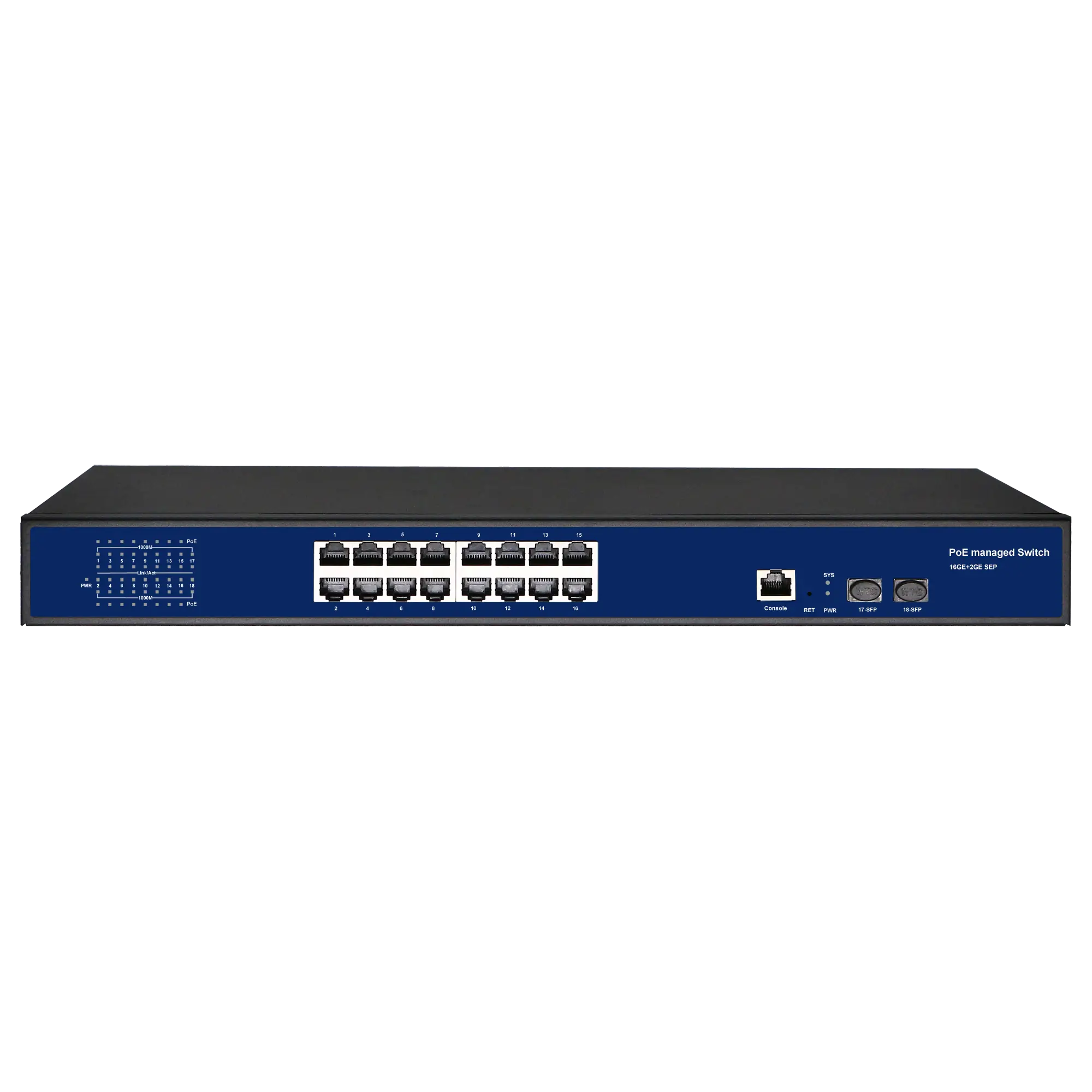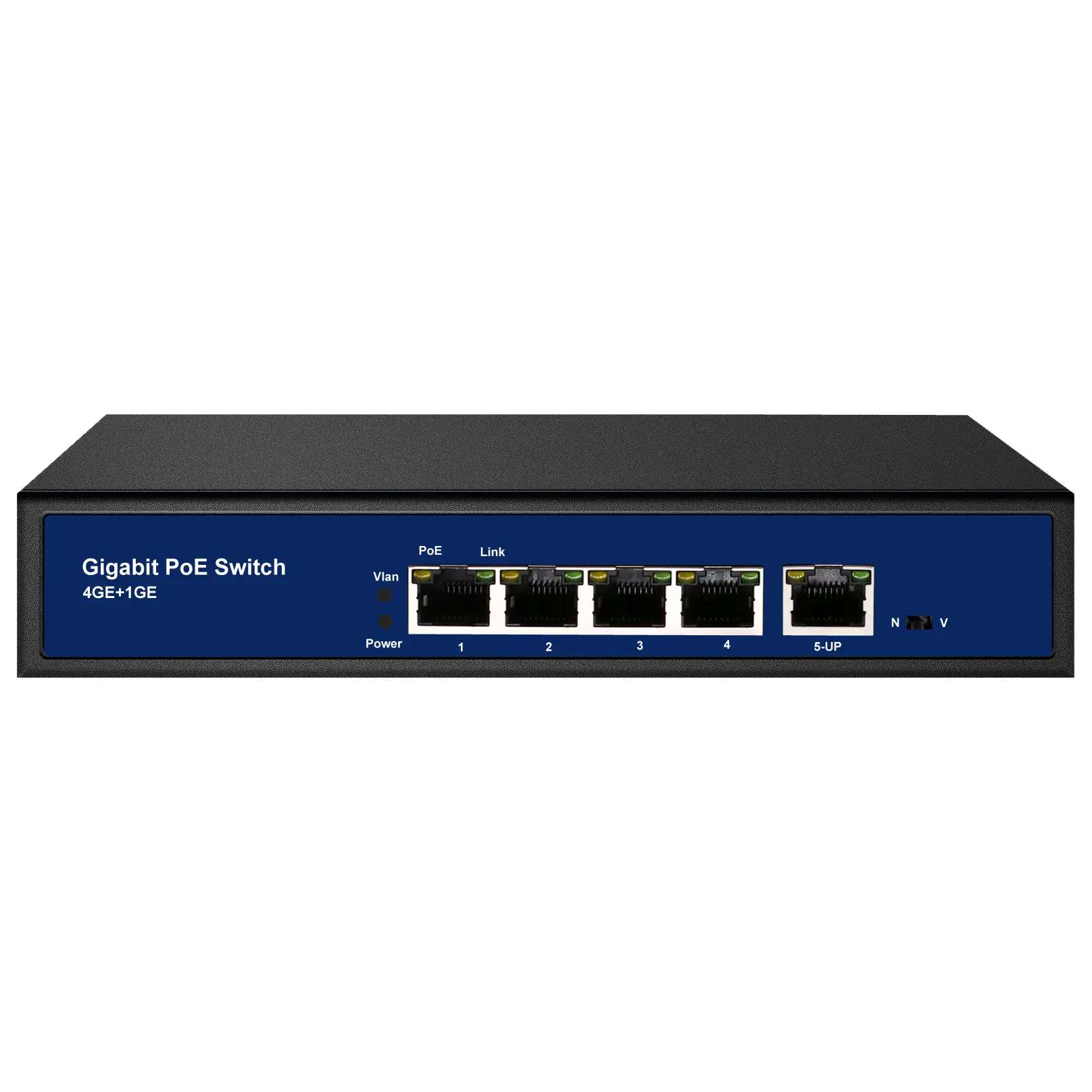Table of Contents
4. Key Features of POE Switches
I. Introduction
Power over Ethernet (POE) is a groundbreaking technology that enables the transmission of both electrical power and data signals over a single Ethernet cable. By eliminating the need for separate power cables, POE simplifies deployments and reduces costs for networked devices such as IP cameras, wireless access points, and IoT sensors. Governed by IEEE standards like 802.3af, 802.3at, and 802.3bt, POE delivers varying levels of power (up to 90W) to meet the demands of diverse applications.
At the heart of this innovation lies the POE switch—a specialized networking device that integrates power sourcing and data switching capabilities. Unlike traditional switches, a POE switch acts as both a Power Sourcing Equipment (PSE) and a network traffic manager, empowering devices like security cameras or VoIP phones to operate in locations without direct access to electrical outlets. This integration makes POE switches indispensable in modern networks, particularly in smart buildings, industrial automation, and scalable IoT ecosystems.
Velolan Networks write this article is to explore the functions, benefits, applications, and selection criteria of POE switches. Whether you are an IT professional planning a network upgrade or a tech enthusiast curious about infrastructure trends, this guide will equip you with the knowledge to leverage POE technology effectively.
II. What is a POE Switch?
Definition
A POE (Power over Ethernet) switch is a network device that combines traditional data switching capabilities with the ability to deliver electrical power over the same Ethernet cable. By integrating power sourcing and data transmission, it eliminates the need for separate power supplies for connected devices, streamlining network infrastructure and enabling deployment flexibility.
Key Components
POE and Non-POE Ports
POE Ports: Deliver both data and power (e.g., 48V DC) to compatible devices.
Non-POE Ports: Transmit data only, ideal for non-power-hungry devices like computers or printers.
Power Budget
The total wattage a switch can allocate across all POE ports (e.g., a 150W switch may support 10× 15W devices or 5× 30W devices).
Standards Compliance
Adherence to IEEE standards (e.g., 802.3af, 802.3at, 802.3bt) ensures compatibility and safe power delivery.
III. POE Standards
1. IEEE 802.3af (POE)
Power Output: Delivers up to 15.4W per port (12.95W usable after accounting for cable losses).
Voltage: 48V DC over two pairs of Ethernet cables.
Use Cases: Designed for low-power devices such as:
IP Phones
Basic Security Cameras
Environmental Sensors
Entry-Level Wireless Access Points
Limitations: Insufficient for high-demand devices like PTZ cameras or advanced IoT systems.
2. IEEE 802.3at (POE+)
Power Output: Supplies up to 30W per port (25.5W usable).
Voltage: Maintains 48V DC but optimizes power efficiency through advanced negotiation protocols.
Use Cases: Supports energy-intensive devices such as:
PTZ (Pan-Tilt-Zoom) Security Cameras
High-Performance Wireless Access Points (e.g., Wi-Fi 6)
Video Conferencing Systems
Biometric Access Controls
Advantage: Backward compatible with 802.3af devices.
3. IEEE 802.3bt (POE++/4PPoE)
Power Output:
Type 3: Up to 60W per port (51W usable).
Type 4: Up to 90W per port (71W usable).
Voltage: Utilizes all four pairs of Ethernet cables (Cat6a or higher recommended).
Use Cases: Powers advanced infrastructure and industrial equipment:
LED Lighting Systems
Digital Signage and Kiosks
Thin Client Computers
5G Small Cell Nodes
Industrial Automation Controllers
Key Feature: Enables high-density deployments with minimal cabling.
4. Non-Standard POE
Definition: Proprietary power delivery systems that bypass IEEE standards (e.g., passive POE).
Risks:
Device Damage: Lack of auto-sensing may send power to non-POE devices, causing malfunctions.
Compatibility Issues: May fail to work with standards-compliant equipment.
Safety Concerns: Overheating or short circuits due to unregulated voltage.
Recommendation: Avoid non-standard POE unless explicitly required, and always verify compatibility.
Why Standards Matter
Adhering to IEEE standards ensures interoperability, safety, and future-proofing. For instance, a POE++ switch (802.3bt) can power a 4K digital signage display while simultaneously supporting legacy devices like IP phones through backward compatibility.
Velolan Networks provide PoE switches at standard PoE/PoE+/PoE++ and Passive PoE, to satisfy different application.
IV. Key Features of POE Switches
1. Power Budget Management
Definition: The total power capacity (e.g., 240W, 400W) a POE switch can allocate to connected devices.
Dynamic Allocation: Prioritizes power distribution based on device demands. For example:
A 30W PTZ camera receives full power, while idle sensors draw minimal wattage.
Critical Calculation: Total power budget must exceed the combined needs of all POE devices.
Example: A switch with a 150W budget can support 5× 30W devices (802.3at) but not 3× 60W devices (802.3bt).
2. Auto-Sensing Technology
Function: Automatically detects Powered Devices (PDs) and negotiates power delivery.
Uses a signature detection mechanism to identify IEEE-compliant devices.
Avoids sending power to non-POE equipment (e.g., laptops), preventing damage.
Flexibility: Adjusts power output based on the connected device’s standard (e.g., 15W for 802.3af, 30W for 802.3at).
3. Network Management Options
Unmanaged Switches:
Plug-and-play operation with no configuration required.
Ideal for small networks (e.g., home offices, retail shops).
Managed Switches:
Advanced Controls:
SNMP (Simple Network Management Protocol): Monitor traffic and device status remotely.
VLANs: Segment networks for security and performance (e.g., isolating cameras from guest Wi-Fi).
QoS (Quality of Service): Prioritize critical traffic (e.g., VoIP calls over file transfers).
Best for enterprise networks, campuses, or IoT deployments requiring scalability.
4. Layer 2 vs. Layer 3 Switches
Layer 2 Switches:
Operate at the data link layer (MAC address-based forwarding).
Basic features: VLAN support, port mirroring.
Use case: Small to medium networks with simple routing needs.
Layer 3 Switches:
Operate at the network layer (IP address-based routing).
Advanced features: Inter-VLAN routing, ACLs (Access Control Lists), DHCP server support.
Use case: Large enterprises, data centers, or networks requiring granular traffic control.
Practical Example
A managed Layer 3 POE switch in a university campus might:
Allocate 90W to a digital signage display (802.3bt).
Use QoS to prioritize video lectures over student Wi-Fi.
Employ VLANs to separate administrative and student networks.
You can contact Velolan Networks to choose unmanaged/managed, Layer 2/Layer 3 managed switches in the catalog.
V. Advantages of POE Switches
1. Simplified Installation
Reduced Cabling: A single Ethernet cable replaces separate power and data lines, minimizing clutter.
No Local Power Outlets: Devices like ceiling-mounted security cameras or outdoor Wi-Fi access points can be installed in hard-to-reach areas.
Faster Deployment: Eliminates the need for licensed electricians to install AC wiring, accelerating project timelines.
Example: Deploying 20 IP cameras across a warehouse requires only Ethernet cabling, avoiding costly electrical retrofitting.
2. Cost Efficiency
Lower Infrastructure Costs: Saves on power cables, outlets, and circuit breakers.
Reduced Labor Costs: Simplified installation cuts downtime and technician fees.
Energy Savings: Advanced POE switches optimize power usage (e.g., sleep modes for idle devices).
Case Study: A retail store cut deployment costs by 40% by using a POE switch to power LED lighting and surveillance systems.
3. Flexibility
Remote Placement: Devices operate up to 100 meters from the switch, ideal for:
Outdoor security cameras.
Parking lot sensors.
Rooftop wireless access points.
Easy Relocation: Devices can be moved without rewiring (e.g., reconfiguring office layouts).
Example: A smart farm uses POE switches to power weather sensors and irrigation controls across vast fields.
4. Scalability
Plug-and-Play Expansion: Add new IoT devices (e.g., occupancy sensors, smart locks) without overhauling infrastructure.
Future-Proofing: High-power standards (e.g., 802.3bt) support next-gen devices like 8K displays or AI-powered cameras.
Use Case: A hospital scales its patient monitoring system by connecting additional medical IoT devices to existing POE switches.
5. Safety
Overload Protection: Automatically cuts power if a short circuit or excess load is detected.
Intelligent Shutoff: Stops power delivery to malfunctioning devices, preventing fire hazards.
Standards Compliance: IEEE protocols ensure safe voltage levels (44–57V DC), reducing risks of electric shock.
Example: A POE switch powers down a faulty access point, avoiding damage to the network while alerting IT staff via SNMP.
Why These Advantages Matter
POE switches transform rigid, expensive networks into agile, cost-effective ecosystems. For instance, a smart city project can deploy traffic cameras, environmental sensors, and public Wi-Fi hotspots using a single POE infrastructure—dramatically reducing complexity and long-term maintenance costs.
VI. Common Applications
1. IP Surveillance Systems
POE-Powered Devices:
IP Cameras: High-resolution, PTZ, and thermal cameras (e.g., 4K models).
Network Video Recorders (NVRs): Centralized storage and management.
Benefits:
Single-cable deployment for cameras mounted on ceilings, poles, or outdoor enclosures.
Simplified integration with motion detection and AI analytics platforms.
Example: A citywide traffic monitoring system uses POE switches to power hundreds of cameras along highways, reducing wiring complexity by 60%.
2. Wireless Networks
POE-Powered Devices:
Wi-Fi Access Points (APs): Supports Wi-Fi 6/6E and mesh networks.
Wireless Repeaters: Extends coverage in dead zones (e.g., basements, parking garages).
Benefits:
Enables ceiling-mounted APs without nearby power outlets.
Scalable coverage for high-density environments (e.g., stadiums, conference centers).
Use Case: A university campus deploys POE switches to power 200+ Wi-Fi 6 APs, ensuring seamless connectivity for 10,000+ users.
3. Smart Buildings
POE-Powered Devices:
LED Lighting Systems: Programmable, energy-efficient fixtures with centralized control.
HVAC Controls: Smart thermostats and occupancy sensors.
Access Systems: Biometric scanners and electronic door locks.
Benefits:
Unified infrastructure for lighting, security, and climate control.
Real-time adjustments via building management systems (BMS).
Example: A LEED-certified office building uses POE to power 500+ smart lights, cutting energy consumption by 35% through motion-activated dimming.
4. Industrial IoT
POE-Powered Devices:
Sensors: Temperature, vibration, and air quality monitors.
RFID Readers: Inventory tracking in warehouses.
Automation Controllers: PLCs (Programmable Logic Controllers) and robotic arms.
Benefits:
Ruggedized POE switches (IP67-rated) withstand harsh environments (dust, moisture, extreme temperatures).
Reduced downtime with centralized power and data management.
Use Case: A manufacturing plant uses POE to connect 150+ sensors on assembly lines, predicting equipment failures and reducing maintenance costs by 25%.
5. VoIP Systems
POE-Powered Devices:
IP Phones: Enterprise-grade handsets with video capabilities.
Conference Systems: Speakerphones and video conferencing bars (e.g., Microsoft Teams Rooms).
Benefits:
Eliminates clutter from power adapters in office spaces.
Ensures uninterrupted communication during power outages (when paired with UPS).
Example: A call center deploys POE switches to power 300+ IP phones, streamlining upgrades and reducing cable management costs by 50%.
Cross-Industry Impact
From urban infrastructure to smart homes, POE switches act as the backbone of connected ecosystems. For instance, a smart city project might deploy POE to power streetlights with embedded air quality sensors, traffic cameras, and public Wi-Fi hotspots—all managed through a single network.
VII. How to Choose a POE Switch
1. Determine Power Needs
Step 1: List all POE devices (e.g., 10x IP cameras at 7W each, 5x Wi-Fi 6 APs at 20W each).
Step 2: Calculate total power demand:
Example: (10×7W) + (5×20W) = 70W + 100W = 170W total.
Step 3: Choose a switch with a power budget exceeding the total (e.g., 200W for headroom).
Pro Tip: Prioritize switches with dynamic power allocation to optimize usage.
2. Port Requirements
POE vs. Non-POE Ports:
Select a mix based on device types (e.g., 8 POE ports for cameras + 4 non-POE for PCs).
Speed:
Gigabit (10/100/1000 Mbps is recommended for high-bandwidth tasks (e.g., 4K video streaming).
Multi-Gigabit (2.5G/5G/10G)for future-proofing advanced IoT or AI applications.
Scalability: Ensure spare ports for future expansions.
3. Managed switch vs. Unmanaged switch
Unmanaged Switches:
Best for: Small offices, retail stores, or simple networks.
Limitations: No traffic prioritization or security controls.
Managed Switches:
Best for: Enterprises, campuses, or IoT-heavy environments.
Key Features:
VLANs: Isolate devices (e.g., separate security cameras from guest Wi-Fi).
QoS: Prioritize VoIP or video traffic.
Remote Monitoring: Use SNMP or cloud platforms for real-time alerts.
4. Standards Compatibility
Match Standards to Devices:
802.3af (15W): IP phones, basic sensors.
802.3at (30W): PTZ cameras, high-end APs.
802.3bt (90W): Digital signage, thin clients.
Avoid Non-Standard POE: Risk device damage or network instability.
Future-Proofing: Choose 802.3bt switches if planning to deploy high-power IoT devices.
5. Environmental Factors
Industrial Use:
Ruggedized Design: Look for IP67-rated, fanless switches resistant to dust, moisture, and vibrations.
Operating Temperature: -40°C to 75°C for harsh environments.
Outdoor Use:
Weatherproof Enclosures: Protect against rain and UV exposure.
Surge Protection: Guard against lightning strikes.
Office/Indoor Use: Standard switches with quiet operation and compact form factors.
Example Scenario
A school upgrading its IT infrastructure might choose:
Switch Type: Managed 24-port Gigabit POE+ switch (802.3at).
Power Budget: 400W to support 20x 15W IP cameras and 10x 25W Wi-Fi 6 APs.
Features: VLANs to separate student and staff traffic, QoS for e-learning platforms.
Environmental: Rack-mounted with surge protection for server rooms.
Common Mistakes to Avoid
Underestimating Power Budget: A 150W switch cannot power 10x 30W devices (300W needed).
Ignoring Standards: Using a 802.3af switch for a 25W PTZ camera causes unstable operation.
Overlooking Cooling: High-power switches in enclosed spaces may overheat without ventilation.
VIII. Future Trends
1. Higher Power Delivery
Next-Gen Standards:
Emerging standards like IEEE 802.3bu (under discussion) aim to deliver 120W–150W per port, enabling POE to power small appliances (e.g., monitors, laptops) and industrial tools.
Applications:
Office Spaces: Powering desktop workstations and video conferencing setups via Ethernet.
Healthcare: Medical devices like portable ultrasound machines or infusion pumps.
Retail: Self-checkout kiosks and interactive displays.
Challenges:
Heat dissipation and cable quality (Cat8 or fiber may become necessary for ultra-high power).
2. Smart Energy Management
AI-Driven Optimization:
Machine learning algorithms analyze usage patterns to dynamically allocate power (e.g., reducing wattage to idle devices).
Predictive maintenance: Detect failing devices by monitoring power consumption anomalies.
Green Energy Integration:
POE switches paired with solar/wind systems to create self-sustaining IoT networks (e.g., smart agriculture in off-grid areas).
Use Case: A smart office uses AI-powered POE switches to cut energy costs by 30% by dimming lights and HVAC in unoccupied rooms.
3. Integration with 5G and IoT
Edge Computing Synergy:
POE switches act as edge nodes, processing data locally for 5G-enabled applications (e.g., autonomous vehicles, AR/VR).
Ultra-low latency: Power and manage 5G small cells for real-time industrial automation.
IoT Scalability:
Support for massive IoT deployments (e.g., smart city sensors, drone charging stations) with unified power/data infrastructure.
LPWA (Low-Power Wide-Area) integration: Extend POE to hybrid networks using LoRaWAN or NB-IoT.
Example: A factory uses POE switches to connect 5G-enabled robotic arms and AI quality-control cameras, achieving sub-1ms response times.
Emerging Innovations
Wireless POE:
Experimental technologies combining Wi-Fi 7 and inductive charging to power devices without physical cables.
Blockchain for Energy Sharing:
Decentralized POE networks where devices trade surplus power (e.g., a solar-powered sensor selling energy to a camera).
Bi-Directional POE:
Devices like EV chargers or energy harvesters could both receive and send power back to the grid via Ethernet.
The Road Ahead
By 2030, POE technology may underpin smart grids, autonomous urban infrastructure, and AI-driven ecosystems. Imagine a highway where POE-powered sensors monitor traffic, charge electric vehicles wirelessly, and relay data to 5G-connected autonomous trucks—all through a single, intelligent network.
IX. Conclusion
POE switches have revolutionized modern networking by seamlessly integrating power and data delivery into a single, efficient infrastructure. From powering security cameras in remote locations to enabling scalable IoT ecosystems, these devices eliminate the complexities of traditional cabling while reducing costs and enhancing flexibility. As industries increasingly adopt smart technologies—whether in buildings, cities, or factories—POE switches serve as the backbone that supports innovation, scalability, and sustainability.
The rise of smart infrastructure, driven by 5G, AI, and edge computing, underscores the growing importance of POE technology. With advancements like 90W power delivery and AI-driven energy management, POE switches are no longer just a convenience but a strategic necessity for future-proof networks.
Before investing in a POE switch, carefully evaluate your network’s current needs and future goals. Consider factors like power budgets, device compatibility, and environmental demands to choose a solution that aligns with your vision. By doing so, you’ll unlock the full potential of POE technology—transforming your network into a agile, cost-effective, and intelligent system ready for tomorrow’s challenges.





